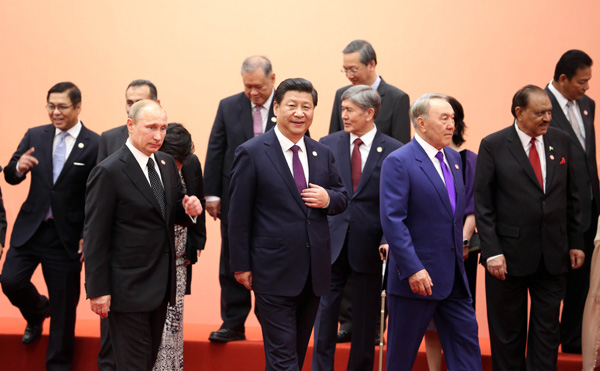Xi: Joint drill shows new level of trust
(China Daily) Updated: 2014-05-21 02:53
 |
|
President Xi Jinping attends a State banquet with other leaders attending the Summit of the Conference on Interaction and Confidence Building Meassures in Asia in Shanghai on Tuesday. [Photo by Wu Zhiyi/China Daily] |
China, Russia increase naval defense cooperation
The joint drill between the Chinese and Russian navies is expected to improve the two forces' capability to conduct maritime defense operations, Chinese experts said on Tuesday.
The drill features new exercises and will simulate real combat situations, according to Zhang Junshe, a researcher with the People's Liberation Army Naval Military Studies Research Institute.
"The two navies for the first time will practice joint checks to identify aircraft flying over the East China Sea, aiming to enhance their cooperation in defense against hostile airplanes," he said.
In addition, combat groups with Chinese and Russian vessels mixed together will face off against each other during the drills, which will allow crew members from both nations to get familiar with each other's weapons, equipment and operational patterns.
Zhang's remarks came as President Xi Jinping and his Russian counterpart Vladimir Putin announced the opening of the Joint Sea-2014 drill in Shanghai on Tuesday.
The Russian president is on a state visit to China and attending the fourth Summit of the Conference on Interaction and Confidence Building Measures in Asia.
Xi said at the opening ceremony that the drill shows the two sides' firm determination and strong will to cooperate in handling new threats and challenges as well as safeguarding regional safety and stability.
It will display to the world the new level of strategic trust and collaboration between the two nations, he added.
Putin said the two militaries share a deep friendship and their relationship is an important part of the bilateral cooperative partnership.
Fourteen ships, two submarines, nine fixed-wing aircraft and several helicopters from the two navies will take part in the drill, which will last seven days.
The drill will test the two parties' capabilities to launch joint operations such as anti-ship strikes, anti-submarine combat and rescue of hijacked vessels.
This will be the third such exercise after joint drills off the coast of Russia's Far East in July and the Yellow Sea in April 2012.
The two nations want to strengthen coordination in maritime operations through such exercises, which are not directed against any third party, according to Senior Captain Liang Yang, a spokesman for the PLA.
Zhang said China has allocated many cutting-edge armaments in its ordnance such as the Zhengzhou, a missile destroyer that entered into service last year. It is equipped with a multifunction phased array radar for 360-degree coverage as well as several sets of HHQ-9 long-range air defense missiles.
Li Li, a military technology professor with the PLA National Defense University, said that the use of Sukhoi Su-30 and J-10 fighter jets requires a high level of coordination with combatant ships because communication between aircraft and ships for maritime operations is very sophisticated.
"In the past, the PLA navy has long depended on JH-7 fighter bombers in the airstrikes to surface vessels," she told China Central Television. "The use of Su-30 and J-10 fighter jets will significantly strengthen the PLA navy's ability to launch strikes against ships."
Russia also sent some of its top-tier vessels to the drill including the Slava-class missile cruiser Varyag and Sovremenny-class destroyer Bystryy.










